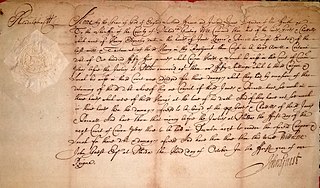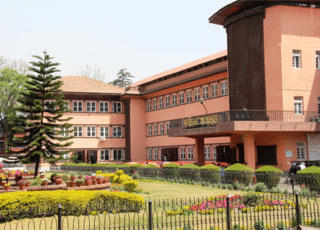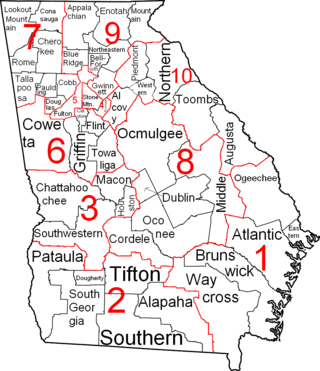Habeas corpus is a recourse in law through which a person can report an unlawful detention or imprisonment to a court and request that the court order the custodian of the person, usually a prison official, to bring the prisoner to court, to determine whether the detention is lawful.
Mandamus is a judicial remedy in the form of an order from a court to any government, subordinate court, corporation, or public authority, to do some specific act which that body is obliged under law to do, and which is in the nature of public duty, and in certain cases one of a statutory duty. It cannot be issued to compel an authority to do something against statutory provision. For example, it cannot be used to force a lower court to take a specific action on applications that have been made, but if the court refuses to rule one way or the other then a mandamus can be used to order the court to rule on the applications.
In law, certiorari is a court process to seek judicial review of a decision of a lower court or government agency. Certiorari comes from the name of an English prerogative writ, issued by a superior court to direct that the record of the lower court be sent to the superior court for review. The term is Latin for "to be made certain", and comes from the opening line of such writs, which traditionally began with the Latin words "Certiorari volumus...".

In common law, a writ is a formal written order issued by a body with administrative or judicial jurisdiction; in modern usage, this body is generally a court. Warrants, prerogative writs, subpoenas, and certiorari are common types of writ, but many forms exist and have existed.
In law, especially English and American common law, quo warranto is a prerogative writ requiring the person to whom it is directed to show what authority they have for exercising some right, power, or franchise they claim to hold. Quo warranto is also used, with slightly different effect, in the Philippines.
In common law legal systems, original jurisdiction of a court is the power to hear a case for the first time, as opposed to appellate jurisdiction, when a higher court has the power to review a lower court's decision.

The Supreme Court is the highest court in the Philippines. The Supreme Court was established by the Second Philippine Commission on June 11, 1901 through the enactment of its Act No. 136, an Act which abolished the Real Audiencia de Manila, the predecessor of the Supreme Court.

The Supreme Court of Nepal is the highest court in Nepal. It has appellate jurisdiction over decisions of the seven High Courts and extraordinary original jurisdiction. The court consists of twenty Justices and one Chief Justice.

The High Court Division, Supreme Court of Bangladesh popularly known as the 'High Court' is one of the two divisions of the Supreme Court of Bangladesh, the other division being the Appellate Division. It consists of the Chief Justice of Bangladesh and the Judges of the High Court Division.
In the Philippines, amparo and habeas data are prerogative writs to supplement the inefficacy of the writ of habeas corpus. Amparo means 'protection,' while habeas data is 'access to information.' Both writs were conceived to solve the extensive Philippine extrajudicial killings and forced disappearances since 1999.

The Peshawar High Court is the provincial and highest judicial institution of Khyber Pakhtunkhwa in Pakistan. It is located in the provincial capital Peshawar. The Parliament passed a bill extending the jurisdiction of the Supreme Court (SC) and the Peshawar High Court (PHC) to Federally Administered Tribal Areas (FATA), one of a handful of reforms paving the way for a merger of the tribal areas with Khyber Pakhtunkhwa.

The Florida circuit courts are state courts, and are trial courts of original jurisdiction for most controversies. In Florida, the circuit courts are one of four types of courts created by the Florida Constitution.
In most legal systems of the Spanish-speaking world, the writ of amparo is a remedy for the protection of constitutional rights, found in certain jurisdictions. The amparo remedy or action is an effective and inexpensive instrument for the protection of individual rights.

The Washington Court of Appeals is the intermediate level appellate court for the state of Washington. The court is divided into three divisions. Division I is based in Seattle, Division II is based in Tacoma, and Division III is based in Spokane.

The remedies available in Singapore administrative law are the prerogative orders – the mandatory order, prohibiting order (prohibition), quashing order (certiorari), and order for review of detention – and the declaration, a form of equitable remedy. In Singapore, administrative law is the branch of law that enables a person to challenge an exercise of power by the executive branch of the Government. The challenge is carried out by applying to the High Court for judicial review. The Court's power to review a law or an official act of a government official is part of its supervisory jurisdiction, and at its fullest may involve quashing an action or decision and ordering that it be redone or remade.

The Superior Court is Georgia's general jurisdiction trial court. It has exclusive, constitutional, authority over felony cases, divorce, equity and cases regarding title to land. The exclusive jurisdiction of this court also covers such matters as declaratory judgments, habeas corpus, mandamus, quo warranto and prohibition. The Superior Court corrects errors made by lower courts by issuing writs of certiorari; for some lower courts, the right to direct review by the Superior Court applies.

The Indian High Courts Act 1861 was an act of the Parliament of the United Kingdom to authorize the Crown to create High Courts in the Indian colony. Queen Victoria created the High Courts in Calcutta, Madras, and Bombay by Letters Patent in 1862. These High Courts would become the precursors to the High Courts in the modern day India, Pakistan, and Bangladesh. The Act was passed after the First War of Independence of 1857 and consolidated the parallel legal systems of the Crown and the East India Company.
The High Court of West Pakistan was the high court for the province of West Pakistan during the days of one unit from 1956 to 1971 until the separation of East Pakistan.
In Canada, judicial review is the process that allows courts to supervise administrative tribunals' exercise of their statutory powers. Judicial review of administrative action is only available for decisions made by a governmental or quasi-governmental authority. The process allows individuals to challenge state actions, and ensures that decisions made by administrative tribunals follow the rule of law. The practice is meant to ensure that powers delegated by government to boards and tribunals are not abused, and offers legal recourse when that power is misused, or the law is misapplied. Judicial review is meant to be a last resort for those seeking to redress a decision of an administrative decision maker.
The judiciary of the Philippines consists of the Supreme Court, which is established in the Constitution, and three levels of lower courts, which are established through law by the Congress of the Philippines. The Supreme Court has expansive powers, able to overrule political and administrative decisions, and with the ability to craft rules and law without precedent. It further determines the rules of procedure for lower courts, and its members sit on electoral tribunals.









